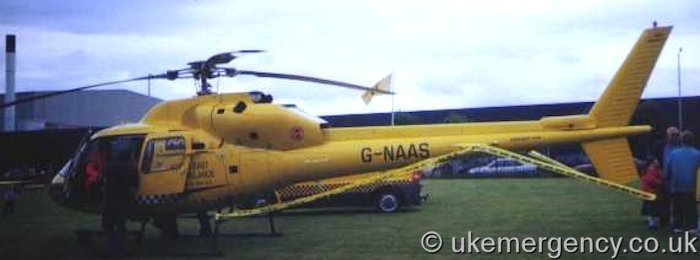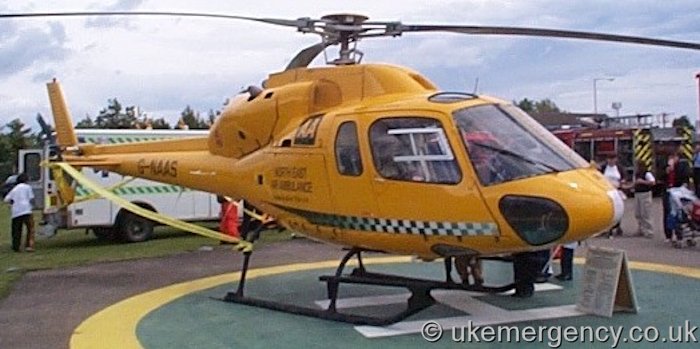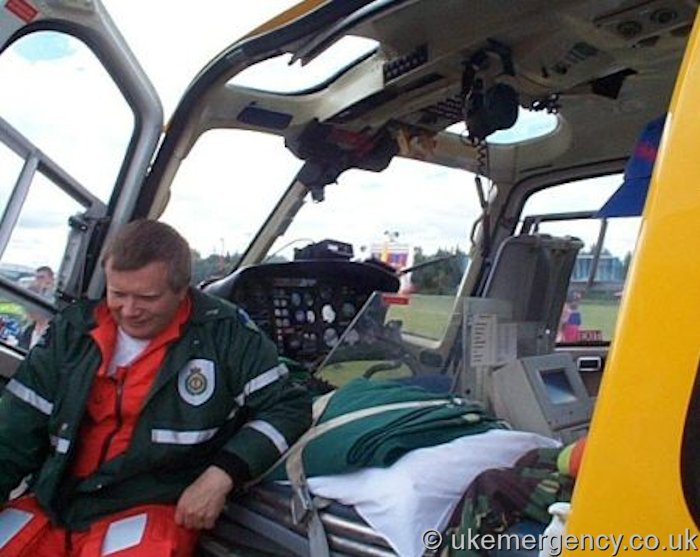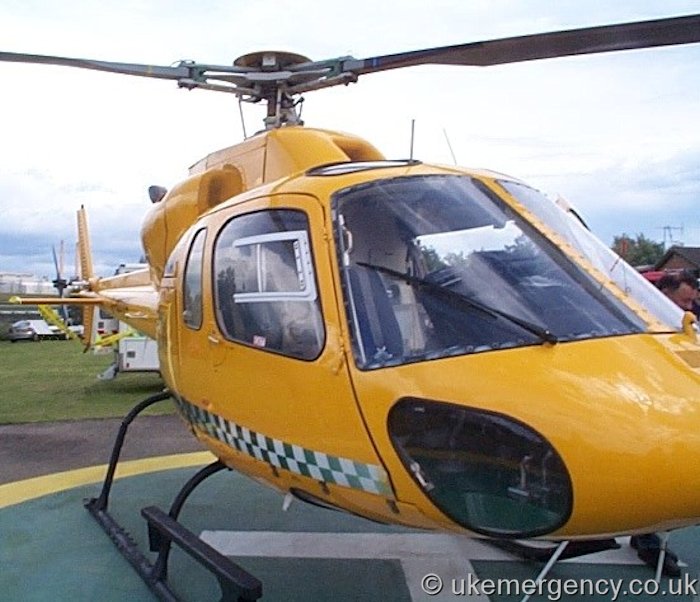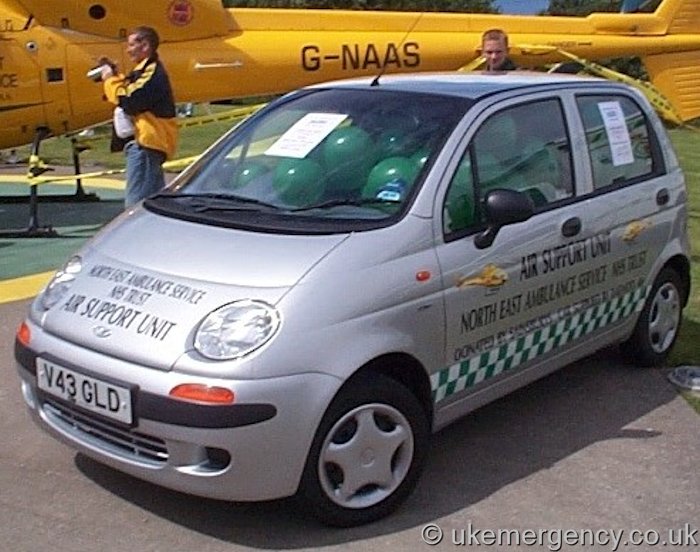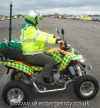Category: AMBULANCE
A closer look at the front of G-GNAA. It is an MD …

A closer look at the front of G-GNAA. It is an MD Explorer helicopter with a dark green a white livery.
Looking at the rear of the helicopter reveals why it is so suited to air ambulance work: it has no rear tail rotor. This makes it much safer for people to walk around the aircraft. The rotor is replaced with air forced at great speed out of a vent in the tail. This counteracts the spinning of the main rotors and keeps the helicopter stable.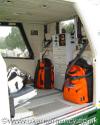
Inside is small, but very tidy and clinical. The orange grab-bags can be seen.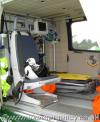
Looking towards the rear of the craft from inside, you can see a seat for the paramedic or doctor caring for the patient on the stretcher. The monitor can also be seen.
The silhouetted view of the underside of the helicopter.
This is G-WYPA, one of the two great north air ambulances…

This is G-WYPA, one of the two great north air ambulances, in flight. Re-liveried and re-launched in March 2003, this Messerschmitt Bolkow Bohlm is based at Teesside Airport. This is the only air ambulance outside of London to carry a specialist NHS doctor on board as well as a paramedic.
The side view of the helicopter in flight. This air ambulance used to be a police helicopter for West Yorkshire Police from 1989-2001. It was built in Germany and the chief police pilot at the time flew it from the factory to West Yorkshire.
A closer look at the livery of G-WYPA.
G-NAAS: The North East Air Ambulance. These photographs…

G-NAAS: The North East Air Ambulance. These photographs were taken in the early 1990s when the aircraft was based at Kitty Brewster Industrial Estate, Blyth. This air ambulance has seen numerous liveries since its introduction and covered the whole of the North East of England.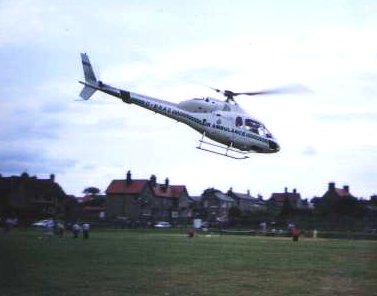
The same helicopter in flight.
A grounded G-NAAS.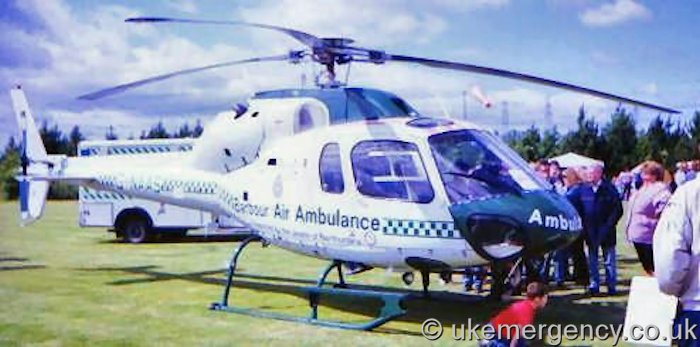
Another view of G-NAAS
Another view of G-NAAS.
This is G-PASG, a Messerschmitt Bolkow Blohm, the…

This is G-PASG, a Messerschmitt Bolkow Blohm, the Yorkshire Air Ambulance. Still in it’s familiar yellow ‘AA’ livery (even though the sponsorship has ended) it has the same colour scheme as most of the air ambulances in the UK. It’s ‘PAS’ callsign is from its owners Police Aviation Services, now known as Specialist Aviation Services.
A patient who was thrown from a horse in the North York Moors has been airlifted to hospital. They are removed from the air ambulance on a stretcher and placed in a road ambulance for the short drive to the accident and emergency department.
The three-man crew of the helicopter prepare to take off to another emergency in West Yorkshire. While the pilot begins to start the engines, the two paramedics load the equipment into the back. The pilot is employed by the ambulance service but is not medically trained.
The stretcher is pushed through from the back of the helicopter so that the head appears next to the rear-seated paramedic. All of the same equipment found on a road ambulance is to hand, but in fewer numbers to keep the weight down.
The second paramedic makes one last check of the area prior to take-off. The rotors are almost at full-speed as the pilot radios air traffic control to request priority status for the emergency journey.
Immediately after taking-off the helicopter skims over the ground at only a few feet before rising almost vertically.
A rather scenic shot of the air ambulance as it makes haste towards the sun.
YJ59 OPC This is one of ten Land Rover Discoveries…

YJ59 OPC This is one of ten Land Rover Discoveries that were new to the YAS area in late 2009. They are used for rapid response duties and allow the possibility of attending calls in inaccessible rural locations or in snow.
The rear view of the Discovery showing the smart livery and thin roof-mounted light bar.
W704 YER This is a yellow Volvo V90 ambulance conversion…

W704 YER This is a yellow Volvo V90 ambulance conversion. It was formerly with Wiltshire Ambulance Service based at Trowbridge. It was one of six identical vehicles bought by Wiltshire and similar vehicles were used in a small number of other services in the UK, including Northumbria. It is now in private hands but kept operational.













